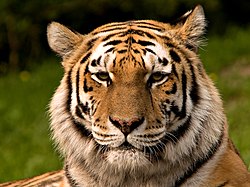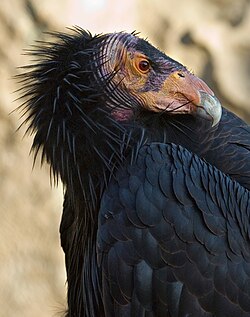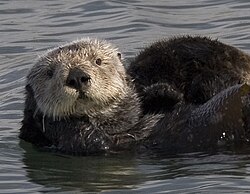Endangered Species
September 27, 2009
| Conservation status |
| by risk of extinction |
| Extinct |
| Extinct Extinct in the Wild |
| Threatened |
| Critically Endangered Endangered Vulnerable Threatened |
| At lower risk |
| Conservation Dependent Near Threatened Least Concern |
|
See also World Conservation Union IUCN Red List |
An endangered species is a population of organisms which is at risk of becoming extinct because it is either few in numbers, or threatened by changing environmental or predation parameters. An endangered species is usually a taxonomic species, but may be another evolutionary significant unit. The International Union for Conservation of Nature (IUCN) has calculated the percentage of endangered species as 40 percent of all organisms based on the sample of species that have been evaluated through 2006.[2] (Note: the IUCN groups all threatened species for their summary purposes.) Many nations have laws offering protection to conservation reliant species: for example, forbidding hunting, restricting land development or creating preserves. Only a few of the many species at risk of extinction actually make it to the lists and obtain legal protection. Many more species become extinct, or potentially will become extinct, without gaining public notice.
Conservation status
The conservation status of a species is an indicator of the likelihood of that endangered species not living. Many factors are taken into account when assessing the conservation status of a species; not simply the number remaining, but the overall increase or decrease in the population over time, breeding success rates, known threats, and so on. The IUCN Red List is the best known conservation status listing.
Internationally, 194 countries have signed an accord agreeing to create Biodiversity Action Plans to protect endangered and other threatened species. In the United States this plan is usually called a species Recovery Plan.
IUCN Red List Endangered species
IUCN Red List of Threatened Species uses the term endangered species as a specific category of imperilment, rather than as a general term. Under the IUCN Categories and Criteria, endangered species is between critically endangered and vulnerable. Also critically endangered species may also be counted as endangered species and fill all the criteria
The more general term used by the IUCN for species at risk of extinction is threatened species, which also includes the less-at-risk category of vulnerable species together with endangered and critically endangered. IUCN categories include:
- Extinct: the last remaining member of the species has died, or is presumed beyond reasonable doubt to have died. Examples: Thylacine, Dodo, Passenger Pigeon, Caribbean Monk Seal
- Extinct in the wild: captive individuals survive, but there is no free-living, natural population. Examples:South China Tiger, Alagoas Curassow
- Critically endangered: faces an extremely high risk of extinction in the immediate future. Examples: Arakan Forest Turtle, Javan Rhino, Brazilian Merganser, Gharial
- Endangered: faces a very high risk of extinction in the near future. Examples: Blue Whale, Giant Panda, Snow Leopard, African Wild Dog, Tiger, Albatross, Crowned Solitary Eagle, Dhole, Rangas,
- Vulnerable: faces a high risk of extinction in the medium-term. Examples: Cheetah, Gaur, Lion, Sloth Bear, Wolverine, Manatee
- Conservation Dependent: The following animal is not severely threatened, but the animal must depend on conservation programs. Examples: Spotted Hyena, Leopard Shark, Black Caiman
- Near Threatened: may be considered threatened in the near future. Examples: Blue-billed Duck, Solitary Eagle, Small-clawed Otter , Maned Wolf
- Least Concern: no immediate threat to the survival of the species. Examples: Nootka Cypress, Wood Pigeon, Harp Seal
United States
Under the Endangered Species Act in the United States, "endangered" is the more protected of the two categories. The Salt Creek tiger beetle (Cicindela nevadica lincolniana) is an example of an endangered subspecies protected under the ESA.
In the United States alone, the “number of known species threatened with extinction is ten times higher than the number protected under the Endangered Species Act” (Wilcove & Master, 2008, p. 414). The US Fish and Wildlife Service as well as the National Marine Fisheries Service are held responsible for classifying and protecting endangered species, yet, adding a particular species to the list is a long, controversial process and in reality it represents only a fraction of imperiled plant and animal life (Wilcove & Master, 2008, p. 414).
Some endangered species laws are controversial. Typical areas of controversy include: criteria for placing a species on the endangered species list, and criteria for removing a species from the list once its population has recovered; whether restrictions on land development constitute a "taking" of land by the government; the related question of whether private landowners should be compensated for the loss of uses of their lands; and obtaining reasonable exceptions to protection laws.
Under the Bush administration, the former policy that required federeal officials to consult a wildlife expert before taking actions that could damage endangered species was lifted. The Bush administration did not do very much to help out endangered species or to protect them. Recently, under Obama's presidency, the policy has been put back into place.
Being listed as an endangered species can have negative effect since it could make a species more desirable for collectors and poachers.[3] This effect is potentially reducible, such as in China where commercially farmed turtles may be reducing some of the pressure to poach endangered species.[4]
Another problem with the listing species is its effect of inciting the use of the "shoot, shovel, and shut-up" method of clearing endangered species from an area of land. Some landowners currently may perceive a diminution in value for their land after finding an endangered animal on it. They have allegedly opted to silently kill and bury the animals or destroy habitat, thus removing the problem from their land, but at the same time further reducing the population of an endangered species.[5] The effectiveness of the Endangered Species Act, which coined the term "endangered species", has been questioned by business advocacy groups and their publications, but is nevertheless widely recognized as an effective recovery tool by wildlife scientists who work with the species. Nineteen species have been delisted and recovered[6] and 93% of listed species in the northeastern United States have a recovering or stable population.[7]
Currently, 1,556 known species in the world have been identified as endangered, or near extinction, and are under protection by government law (Glenn, 2006, Webpage). This approximation, however, does not take into consideration the number of species threatened with endangerment that are not included under the protection of such laws as the Endangered Species Act. According to NatureServe’s global conservation status, approximately thirteen percent of vertebrates (excluding marine fish), seventeen percent of vascular plants, and six to eighteen percent of fungi are considered imperiled (Wilcove & Master, 2008, p. 415-416). Thus, in total, between seven and eighteen percent of the United States’ known animals, fungi, and plants are near extinction (Wilcove & Master, 2008, p. 416). This total is substantially more than the number of species protected under the Endangered Species Act in the United States, which means numerous species are inching closer and closer toward extinction.
Question of ethics
Even in the search to learn more about these species, many ecologists do not take into consideration the impact they leave on the environment and its inhabitants. It is apparent that the “quest for ecological knowledge, which is so critical for informing efforts to understand and conserve Earth’s biodiversity along with valued ecosystem goods and services, frequently raises complex ethical questions”,[8] and there is no clear way to identify and resolve these issues. Environmentalists tend to focus on the whole ecological sphere instead of the welfare of individual animals. Focusing on such a broad view tends to diminish the value of each individual creature. "Biodiversity conservation is currently a principle goal for resource management of 11.5% of the world’s surface area."[9] Large portions of life occur outside these protected areas and must be taken into consideration if the conservation of endangered species is going to be effective.
Impact on biodiversity and endangered species
In order to conserve the biodiversity of the planet, one must take into consideration the reasons why so many species are becoming endangered. “Habitat loss is the most widespread cause of species endangerment in the U.S., affecting 85% of imperiled species” (Wilcove & Master, 2008, p. 416). When an animal’s ecosystem is not maintained, they lose their home and are either forced to adapt to new surroundings or perish. Pollution is another factor that causes many species to become endangered, especially a large proportion of aquatic life. Also, overexploitation, disease (Wilcove & Master, 2008, p. 416), and climate change (Kotiaho et al., 2005, p. 1963) have led to the endangerment of several species.
However, the most important factor leading to the endangerment of the majority of wildlife in the world is the human impact on the species and their environment. “As human use of resources, energy, and space intensified over the past few centuries, the diversity of life has been substantially diminished in most parts of the world” (Ishwaran & Erdelen, 2006, p.179). Basically, as the human impact on the environment increases, the diversity of life decreases. Humans are constantly using the resources and space of other species for themselves, negatively impacting the survival rate of many creatures.
Humans also set standards for which species they think should be saved and which species they find unimportant or undesirable. For example, the coqui frog, an invasive species in Hawaii, is so common there that its “nocturnal singing” reduces the value of homes and prevents hotels from using rooms near forests. Hawaiians have proposed eliminating the frog, and several wildlife managers want to release a pathogen to kill the frogs (Minteer & Collins, 2005, p. 333). The frog has decreased the value of homes and caused a loss of business for several hotels, so the Hawaiians decided it was acceptable to get rid of the group of coqui frog living near them.
Another example where the human impact affected the welfare of a species was in the instance of non-native mute swans establishing themselves at Arrowhead Lake in Vermont. When the population of swans grew to eight birds, the Vermont Fish and Wildlife Department decided to take action. Two swans were eventually killed, angering animal welfare organizations and people living near the lake (Minteer & Collins, 2005, p. 333). The case of the Arrowhead Lake swans demonstrates what one considers the natural environment based on human assumptions. Simply because the swans were not normally living there does not mean it is not part of their natural habitat, and there is certainly no reason for them to be destroyed because of human dissatisfaction.
Yet another example of the human impact in the lives of endangered species is that of the Preble’s meadow jumping mouse. Research has shown that the mouse is not taxonomically different from the Bear Lodge meadow jumping mouse and the US Fish and Wildlife Service has proposed removing the Preble’s mouse from the endangered species list based on this information (Minteer & Collins, 2005, p. 333). This example brings into consideration the role of science in determining the maintenance of a species. It brings into questions whether scientific evidence should be the only resource used to support conservation of biodiversity.
A final example of the human impact on existing species is the issue of toe clipping in ecological research. While ecologists are doing research on different species to advance their knowledge of methods of conservation, they must take into consideration the impact they have on the wildlife they are studying. Toe clipping “has been reported to result in a number of adverse effects on the animals, including inflammation and infection of the feet and limbs” (Minteer & Collins, 2005, p. 334). This example demonstrates how humans must take into consideration the wellbeing of the animal even before they perform research to help conserve the species. The human impact on species and their environments has many negative effects. It is important for humans to help maintain all species in the world and not deter their development.
Species maintaining importance
“Diversity of life and living systems are a necessary condition for human development” (Ishwaran & Erdelen, 2006, p.179). Many question the importance of maintaining biodiversity in today’s world, where conservation efforts prove costly and time consuming. The fact is that the preservation of all species is necessary for human survival. Species should be saved for “aesthetic and moral justifications; the importance of wild species as providers of products and services essential to human welfare; the value of particular species as indicators of environmental health or as keystone species crucial to the functioning of ecosystems; and the scientific breakthroughs that have come from the study of wild organisms” (Wilcove & Master, 2008, p. 418). In other words, species serve as a source of art and entertainment, provide products such as medicine for human wellbeing, indicate the welfare of the overall environment and ecosystem, and provided research that resulted in scientific discoveries. An example of an “aesthetic justification” in conserving endangered species is that of the introduction of the gray wolf into Yellowstone National Park. The gray wolf has brought numerous amounts of tourists to the park and added to the biodiversity in the protected region (Wilcove & Master, 2008, p. 418).
Another example, supporting the conservation of endangered species as providers of products for human wellbeing, is the scrub mint. It has been found that the scrub mint contains an antifungal agent and a natural insecticide (Wilcove & Master, 2008, p. 418). Also, the deterioration of the bald eagle and the peregrine falcon “alerted people to the potential health hazards associated with the widespread spraying of DDT and other persistent pesticides” (Wilcove & Master, 2008, p. 418).
This serves as an example of how certain fish can serve as identifiers of environmental health and protect human life as well as other species. Finally, an example of species providing for scientific discoveries is the instance of the Pacific yew which “became the source of taxol, one of the most potent anticancer compounds ever discovered” (Wilcove & Master, 2008, p. 418-419). Endangered species could prove useful to human development, maintenance of biodiversity and preservation of ecosystems.
Helping preserve endangered species
It is the goal of conservationists to create and expand upon ways to preserve endangered species and maintain biodiversity. There are several ways in which one can aid in preserving the world’s species who are nearing extinction. One such way is obtaining more information on different groups of species, especially invertebrates, fungi, and marine organisms, where sufficient data is lacking.
For example, to understand the causes of population declines and extinction an experiment was conducted on the butterfly population in Finland. In this analysis, the butterflies’ endangered list classification, distribution, density, larval specificity, dispersal ability, adult habitat breadth, flight period and body size were all recorded and examined to determine the threatened state of each species. It was found that the butterflies’ distribution has declined by fifty-one and a half percent, and they have a severely restricted habitat. One example of specific butterflies who have a declining distribution rate are the Frigga’s Fritillary and Grizzled Skipper, who have been affected by habitat loss due to extensive draining of the bogs where they live (Kotiaho et al., 2005, p. 1963-1967). This experiment proves that when we know the causes of endangerment, we can successfully create solutions for the management of biodiversity.
Another way to help preserve endangered species is to create a new professional society dedicated to ecological ethics. This could help ecologists make ethical decisions in their research and management of biodiversity. Also, creating more awareness on environmental ethics can help encourage species preservation. “Courses in ethics for students, and training programs for ecologists and biodiversity managers” all could create environmental awareness and prevent violations of ethics in research and management (Minteer & Collins, 2005, p. 336). One final way in which one can conserve endangered species is through federal agency investments and protection enacted by the federal government. “Ecologists have proposed biological corridors, biosphere reserves, ecosystem management, and ecoregional planning as approaches to integrate biodiversity conservation and socioeconomic development at increasingly larger spatial scales” (Ishwaran & Erdelen, 2006, p.179).
One example of a federal mandated conservation zone is the Northwest Hawaiian Islands Marine National Monument, the largest marine protected area in the world. The monument is essential to the preservation of underwater communities and overfished regions. Only researchers working in the area are permitted to fish, no corals may be removed, and the Department of Homeland Security will enforce restrictions on vessels passing through the waters via satellite imaging. The monument will serve as a home to an estimated seven thousand species, most of which cannot be found anywhere else in the world (Raloff, 2006, p. 92). This environmental monument demonstrates the fact that it is possible to create a safe environment for endangered species, as well as maintaining some of the world’s largest ecosystems.
Captive breeding programs
Captive breeding is the process of breeding rare or endangered species in human controlled environments with restricted settings, such as wildlife preserves, zoos and other conservation facilities.
This technique has been used with great success for many species for some time, with probably the oldest known such instances of captive mating being attributed to menageries of European and Asian rulers, a case in point being the Pere David's Deer. However, captive breeding techniques are usually difficult to implement for highly mobile species like some migratory birds (eg. cranes) and fishes (eg. Hilsa). Additionally, if the captive breeding population is too small, inbreeding may occur due to a reduced gene pool; this may lead to the population lacking immunity to diseases.
Posted by Antonio Villapaz.













